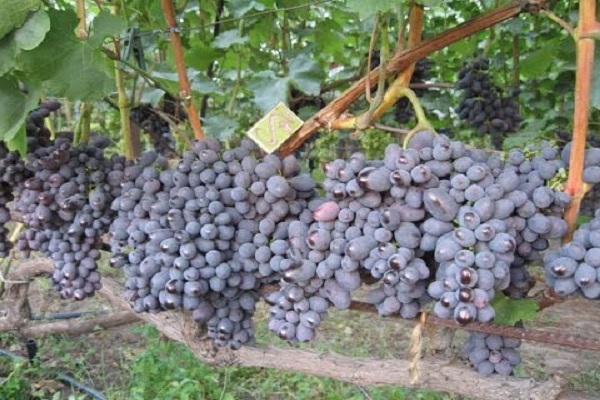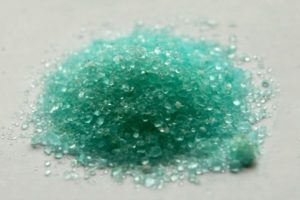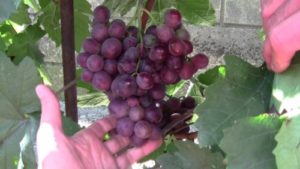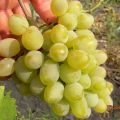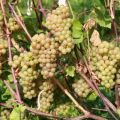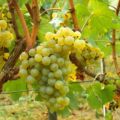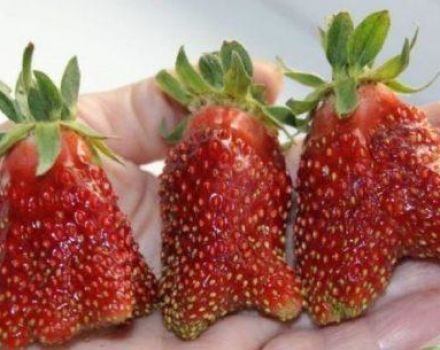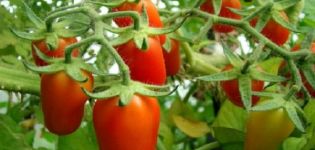Description of the Codrianka fruit grape variety and its characteristics, ripening period, planting and care
The grape berry Kodryanka is appreciated in different regions of the Federation: the variety ripens perfectly, refers to fruitful, early ripening. It is easy to recognize it by its characteristic elongated berry shape and rich dark blue, to a purple hue, color. The taste cannot be called exquisite, it is acceptably sweet. But the bunches ripen in June, earlier than other varieties.
Breeding history
An unpretentious, early ripe species, in fact, created from two: Marshal and Moldova. Codrianka, after crossing, has inherited the qualities of its "parents" and is included in the category of table grape varieties.
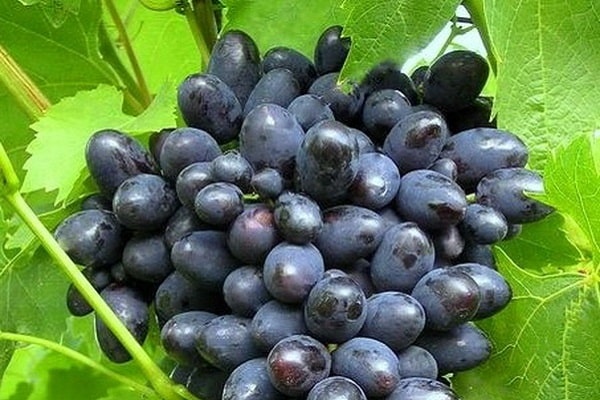
The berry is easy to recognize by its flattened, conical shape; it weighs, on average, up to 8 grams. The hybrid received the taste of pulp, skin color and general appearance from Moldova. Even from her, Kodryanka got immunity to cold weather. And from the Marshalsky variety borrowed yield, growth, resistance to gray rot.
A hybrid species was bred in Moldova, which has long been engaged in the cultivation and collection of grapes. The new variety turned out to be successful, Codryanka is appreciated by gardeners for its unpretentiousness, early ripening and pleasant taste.
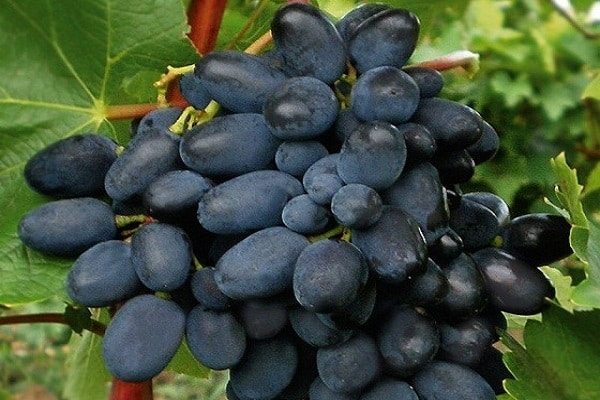
Description of the variety
Any description replaces tasting, but if this is not possible, then you will have to present the merits of Codreanka based on other people's impressions.
The pulp is greenish rather than white, not particularly dense, juicy and tasty. The skin (outer shell) is thick to keep the grapes better, but soft enough. It cannot be compared to the peel of a cucumber or apple, it is much more tender. There are seeds, but they do not affect the taste of the grapes.
This variety is not good for raisins, but good for eating. The sweetness is moderate, not sugary, it is balanced by a slight sourness, together you get an original, piquant taste. In percentage terms, Codryanka contains up to 19% sugar. The bunches are large, on average, 500 grams each, there are also more weighty (up to a kilogram). This is considered an undoubted advantage of the variety.
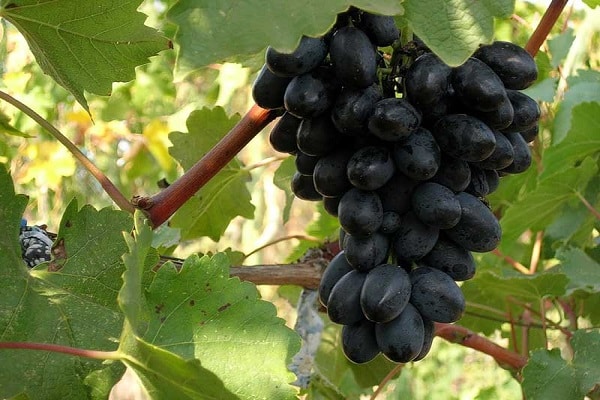
If we are talking about the advantages of the species, then it is worth mentioning the high preservation of the berries - both on the bush and already assembled. Add to this early (no more than 120 days) ripening, the ability to eat grapes before full maturity (there will be no sourness), resistance to gray rot, and a description of the variety for cultivation in all regions of Russia, regardless of the climatic zone, is ready.
Fruit qualities of Codryanka appear quickly, in the next (second) year after planting in the ground and rooting.The large, ripe bunches hanging from the bush are pleasing to the eye and are full of elongated, dark blue berries. The yield remains unchanged for many seasons, however, so does the signature taste.
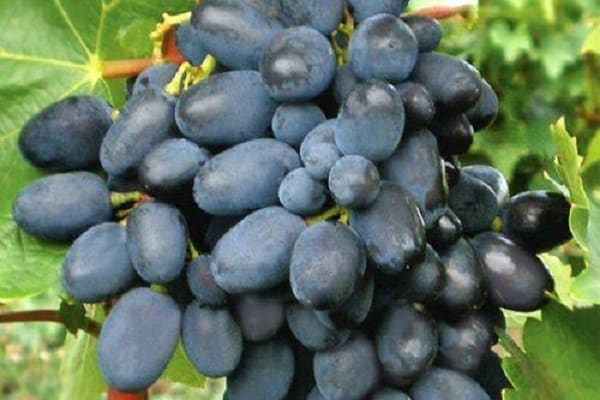
The grapes easily endure transportation without losing their qualities, withstand severe frosts down to -23 ºС, and are almost devoid of drawbacks. But they are still there.
In conditions of a lack of heat and light, there is a high probability of a change in the shape and size of the berry (pea). You can fight this problem using phytohormonal dressings. So it will be possible to stabilize the growth of berries, and also "correct" the flaw of the breeders by bringing out Codryanka without pits.
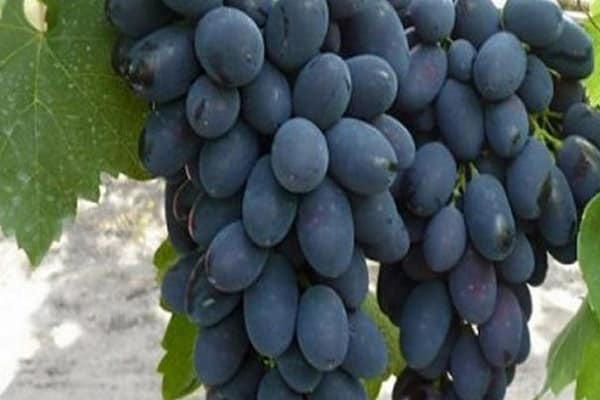
Specifications
Working on the crossing of the Marshalsky and Moldova varieties, the creators tried to make the hybrid retain the characteristics of each of them and even increase these qualities. As a result, they got grapes:
- Delicious.
- Sweet.
- Early ripe.
- Harvestable.
- Moderately sour.
- Disease resistant.
- Immune to low temperatures.
- Preserving presentation on the vine and during transportation.
- With good stability of performance from season to season.
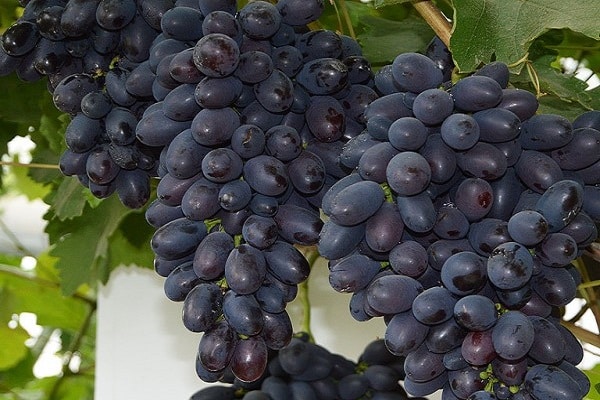
Kodryanka is recognized by gardeners as an unpretentious and stress-resistant variety that is not afraid of frost, unfavorable weather, while it will bring owners a lot of heavy bunches filled with large oblong berries.
He is known and appreciated in the Moscow region, Rostov and the Urals: everywhere, subject to careful care, the shrub will give a generous harvest, repeated from harvest to harvest.
What are the benefits?
Novice growers are often interested in what exactly are the clear advantages of Codryanka, distinguishing it from other, similar in appearance, species. Breeding the perfect berry is not as easy as it seems.

The grapes were originally grown in the southern regions, with mild winters and consistently saturated light, warm summer. Most of the old and newly hatched varieties grow there, the sweetest and most delicious. It is not easy to combine resistance to cold and disease, and not to forget about early maturity, and the size of the berry.
Codreanca has it: moderate sugar content, grapes 6-8 grams each, the weight of a bunch reaches 600 grams and even a kilogram. And it can also be transported without worrying about the presentation of the crop: thanks to the dense shell, the elongated fruits tapering at the end are perfectly preserved on the road.
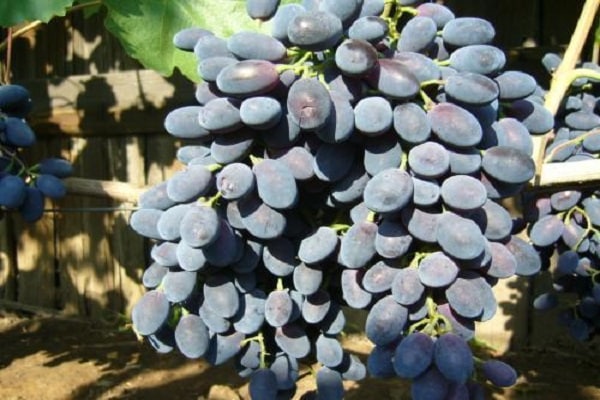
Few, more refined in taste and exterior, varieties are able to compete with Codryanka in terms of resistance to gray rot or frost down to -23 ºС, the ability to mature in the short Siberian or Ural summer. The terms of fruiting (for 2 years) are simply excellent, and the emerging peas can be fought by skillfully using phytohormones.
Landing features
Breeders have done a real miracle by creating this species: any type of soil is suitable for planting - light, heavy, permeable and not very. The adaptation of the variety is fantastic, one-year-old seedlings quickly take root both in the shade and in the sun. It is allowed to use the pinching method. For this, a previously prepared cutting is grafted onto an already existing bush.
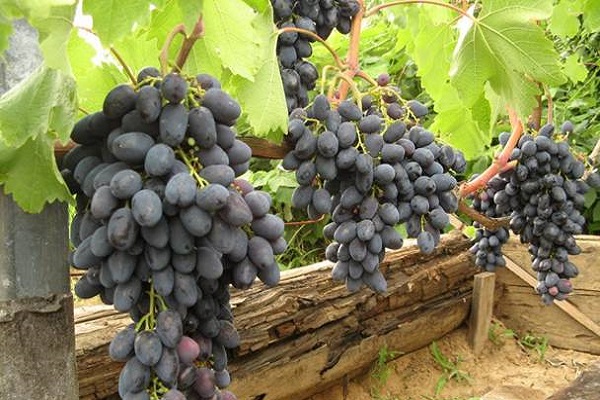
Let's look at the first method first. Before planting the seedling, a place is prepared: for this, a nutrient mixture from the earth and a mineral complex fertilizer is poured into a previously dug hole. All the roots of the future bush are carefully straightened, separated from each other and placed in the ground. Next, it remains to take care of the support (drive in a pin, a picket fence or use an existing one) and generously water the seedling, tying the bush to it.
Before pinching, the top of the cuttings must be paraffinated, soaked in a solution of complex feeding ("humate" or similar).It remains, with the help of a sharp ax or knife, to split the trunk of the mother bush (trunk), place the scion there, tighten it tightly with a strip of cloth and fix it with clay coating.
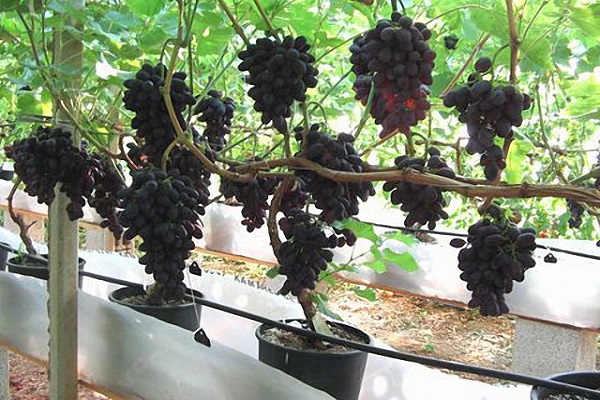
When does it ripen?
Kodryanka ripens early: 3-4 months are enough for the berries to become juicy. You can eat grapes without waiting for the full ripening period. Piquant sourness will add sophistication to the taste, and large, elongated grapes on heavy bunches will decorate the table and become an excellent dessert.
Caring for Codrianka grapes
Maintenance activities include systematic watering, mulching, feeding and sheltering before the winter season, and pruning. This will determine whether the wine bush retains excellent characteristics or not. Care begins with watering: 3 buckets of water for a young plant and about 2 times more for an adult.
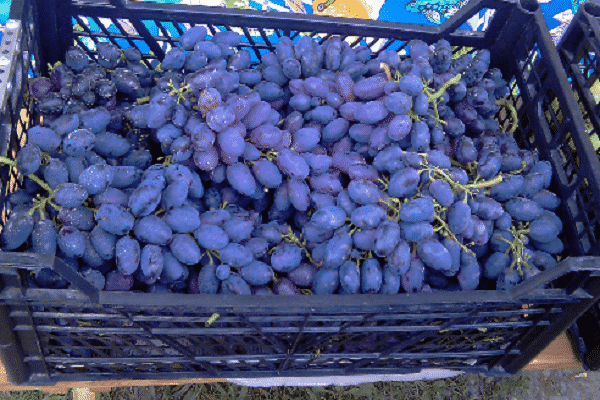
Advice: so that the liquid is simultaneously retained in the soil and does not oversaturate it, mulching is carried out. For this, peat, humus are suitable, you just need not to confuse the dates - before the beginning (after the end) of sap flow, in early spring or late autumn. In no case in the summer - this is how decay of the root system will begin.
Codryanka belongs to cold-resistant species, but at first it, like more thermophilic varieties, is sheltered for the winter. For this purpose, improvised means are suitable: straw, hay, tarpaulin, sawdust. Top dressing (if you use mulch) is not needed at all, but once a year, when a site is dug up in early spring, mineral or organic fertilizers are applied into the soil, under the bushes.
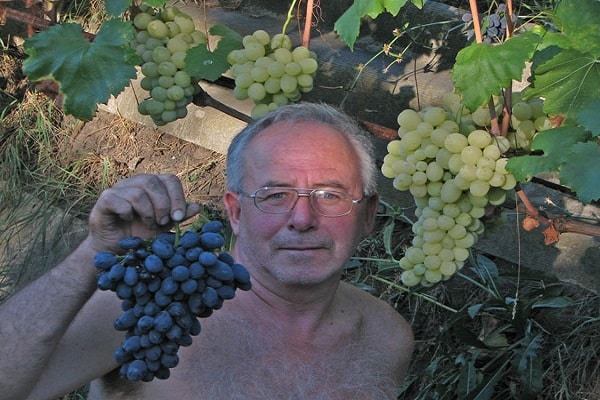
It is important to distribute the layer evenly around the stem. The formation of sleeves by trimming is not initially carried out on the Codryanka. This procedure is started after the berries are ripe, removing weak clusters and directing the growth of shoots in the right direction. Over time, when enough branches appear on an adult plant, including dried ones, it will not be possible to do without pruning, but the young bush can be left alone.
The hybrid has a high natural resistance to most typical diseases, but this does not mean at all that it is completely protected from them. Of course, the bush will not be affected by powdery mildew, leaf rubella or chlorosis, but prevention will have to be performed.
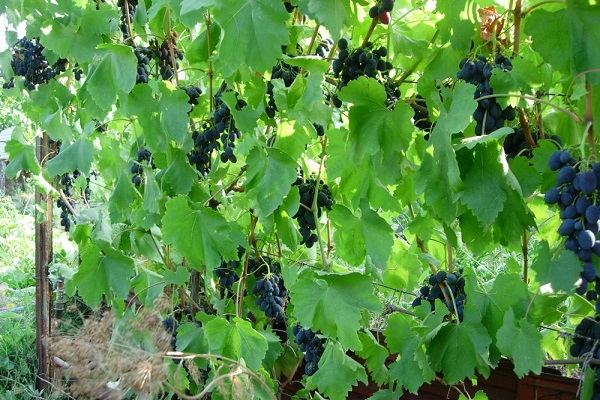
Diseases and pests
Common for other varieties of powdery mildew in different types, gray rot and spotted necrosis, when growing a variety, you can not be afraid: the breeders took care of the plant's immunity to most of these diseases. But this does not mean that over time, traces of the disease will not appear on the leaves or berries.
To avoid problems, you will need to take measures to protect your pet. Treatment for the prevention of diseases is one of the standard measures: despite the high resistance to pathogens, Codreanca needs regular spraying with chemicals.
The use of conventional (not reinforced) formulations will be quite sufficient. Before hibernation, the following measures are applied: tying the stem with spruce branches, hilling with an earthen mixture to create a dense roller (to avoid damage by garden pests).
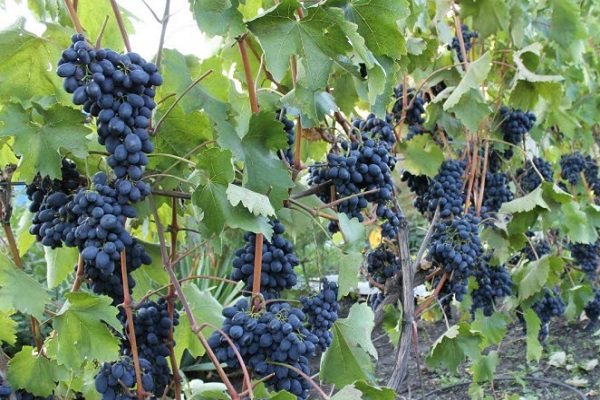
The best regions to grow
The exclusive property of Codryanka is its low selectivity in relation to the place of cultivation, climatic zone. The variety grows equally well in the Moscow region, in the south of Russia, in the Krasnodar Territory, Siberia, the Central Belt - where it has enough warmth and sun to ripen the berries. The shrub easily tolerates winter temperatures down to -23 ºС, and if it is properly covered, it will withstand lower ones.
Ripening conditions within 110-118 days, heavy clusters with large tasty berries make it possible to recommend this species for growing to novice gardeners, as well as to those who doubt the choice of a variety for their region.
